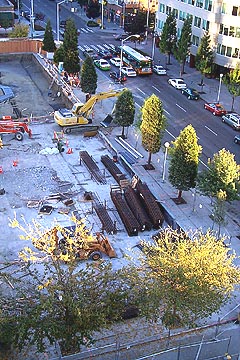|
Subscribe / Renew |
|
|
Contact Us |
|
| ► Subscribe to our Free Weekly Newsletter | |
| home | Welcome, sign in or click here to subscribe. | login |
News
| |
October 25, 1999
Cities crack down on tree loss
By SAM BENNETT
Journal Staff reporter
In its effort to encourage and support new development, the city of Seattle has not been known for taking a tough stance when it comes to protecting trees.
But in Seattle, and other cities nationwide, civic leaders are taking a second look at the ecological and economic value of trees in urban areas, and more cities are ensuring developers replace what they cut down.
To that end, Seattle City Council member Jan Drago as well as a citizens work group of conservationists, builders and tree professionals, have come up with a set of proposals to help preserve the city's tree cover.
A public hearing to discuss the proposals will be held tonight at 6 p.m. in the Washington Park Arboretum Visitor Center, 2300 Arboretum Dr. N.E. Another public hearing will be held in council chambers at 6 p.m. Nov. 1, at 600 Fourth Ave.

Photo by Sam Bennett |
"We are proposing to beef-up existing processes, add some requirements to provide property owners with an incentive to preserve trees and grant flexibility from zoning standards to make tree preservation easier," Drago said. "For the first time, we have a comprehensive program to protect trees."
Drago's recommendations focus on new construction in single-family zones, where she said the greatest number of trees are in danger of being taken down and not replaced during development.
"Recent DCLU inventories indicate that most of the vacant lots within the city are located in single-family zones, and that these lots have significant tree cover," she said. "Nearly 70 percent of the city is zoned single-family, yet we have virtually no regulatory protections for trees when development occurs in these areas."
In Drago's recommendation, lots with less than 3,000 square feet would be required to have three inches (in diameter) of tree per 1,000 square feet. Lots over 3,000 square feet would have to retain or replant two inches of tree per 1,000 square feet. For example, if a property owner were developing a 7,000-square-foot lot, he or she would be required to provide 14 inches of tree on the lot. The ordinance provides a bonus for when existing trees are preserved.
The recommendation would apply to lots zoned single-family, low-rise duplex and triplex and low-rise 1 and low-rise 2 zones (typically townhouses).
In addition, the citizens group worked with DCLU to require inventories of tree cover on new construction projects during the design review process. The proposed guideline revision would require an inventory of trees more than 6 inches in diameter and 4 1/2-feet tall.
The proposal, which applies to multifamily and commercial developments, would require that existing large trees be retained whenever possible. Designers would be encouraged to consider "creative ways to incorporate existing landscape features such as significant trees," the proposal states.
Drago's proposal is modeled after a program in Portland which requires replacing trees removed due to construction. But closer to home, in Redmond and Bellevue, city leaders also have regulations limiting the number of trees that can be removed from development sites.
Bellevue's tree retention requirements don't cover single-family homes, but the city's planning commission is considering that issue.
Bellevue is one of several cities nationwide using a tree inventory software program called CITYGreen, created by the national tree conservation organization American Forests.
The organization contends that storm water run-off and airborne pollutants can be significantly reduced through urban tree planting and retention -- saving cities millions of dollars a year in storm water detention costs. American Forests representatives were in Seattle last week planting trees at Seattle Center, as part of the Global ReLeaf 2000 campaign to plant 20 million trees for the millennium.
Shane DeWald, a senior landscape architect with Seatran, said the city would consider waiving some zoning regulations if developers are willing to preserve tree cover.
"It's the city's responsibility to always be trying to push the envelope in what's possible in terms of tree preservation," she said. "It can be a victory for both the city and the private developer."


